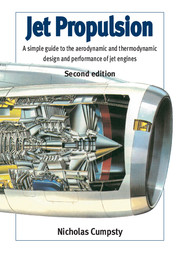 Jet Propulsion
Jet Propulsion from Part 3 - Design of Engines for a New Fighter Aircraft
INTRODUCTION
Figure 15.1 shows a cross-section through a modern engine for a fighter aircraft and the large differences between it and the modern engines used to propel subsonic transport aircraft, Fig. 5.4, are immediately apparent. Above all the large fan which dominates the civil engine, needed to provide a high bypass ratio, is missing. Engines used for combat aircraft typically have bypass ratios between zero (when the engine is known as a turbojet) and about unity; most are now in the range from 0.3 up to about 0.7 at the design point, though the bypass ratio does change substantially at off-design conditions.
This chapter seeks to explain why fighter engines are the way they are. It begins with some discussion of specific thrust, since this is a better way of categorising engines than bypass ratio; fighter engines have higher specific thrust than civil transport engines. Then the components of the engine are described, pointing out special features of components common to the civil engine, and giving a general treatment of the special features: the mixing of the core and bypass stream, the high-speed intake, the afterburner and the variable nozzle. A brief treatment of the thermodynamic aspects of high-speed propulsion leads into the constraints on the performance of engines for combat aircraft and the rating of engines.
In earlier chapters the cooling air supplied to the turbine was neglected in calculating the cycles, so too was the mass flow rate of fuel in the gas through the turbine.
To save this book to your Kindle, first ensure no-reply@cambridge.org is added to your Approved Personal Document E-mail List under your Personal Document Settings on the Manage Your Content and Devices page of your Amazon account. Then enter the ‘name’ part of your Kindle email address below. Find out more about saving to your Kindle.
Note you can select to save to either the @free.kindle.com or @kindle.com variations. ‘@free.kindle.com’ emails are free but can only be saved to your device when it is connected to wi-fi. ‘@kindle.com’ emails can be delivered even when you are not connected to wi-fi, but note that service fees apply.
Find out more about the Kindle Personal Document Service.
To save content items to your account, please confirm that you agree to abide by our usage policies. If this is the first time you use this feature, you will be asked to authorise Cambridge Core to connect with your account. Find out more about saving content to Dropbox.
To save content items to your account, please confirm that you agree to abide by our usage policies. If this is the first time you use this feature, you will be asked to authorise Cambridge Core to connect with your account. Find out more about saving content to Google Drive.